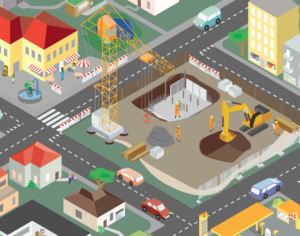It is challenging to design and operate construction sites within space-constrained urban areas. Urban construction sites are often located in close proximity to public streets and roads with a high traffic volume, and a high share of vulnerable road users.
Truck appearances generated by construction sites create temporary risk for urban areas, as urban roads are not primarily designed for trucks, and the truck drivers might not be familiar with local conditions. This results in safety challenges for the project owner, construction and transport companies, and their drivers. Lisa Tronhuus Hannasvik (Norway) wrote an interesting thesis about improving road safety in construction logistics.
Norway
By Norwegian law, project owners and construction companies are obliged to conduct a risk assessment of the site. However, such assessments rarely include road safety outside of the construction site. Therefore, the objective of Lisa’s research was to gain a better understanding of the road safety considerations associated with deliveries to urban construction sites.
Particularly interesting is the information flow between stakeholders involved in construction operations, regarding the site-specific access and loading information truck drivers receive when delivering to construction sites. Lisa recommends improving this flow of information for improved safety while delivering to sites.
Lisa performed in-depth and focused interviews. The first set of interviews were conducted with seven truck drivers and six transport company managers to identify road safety problems and barriers in the
information flow regarding access, on-site driving, and loading. Based on the findings from these interviews, a construction site manager and a project owner were interviewed in two rounds of interviews. The main purpose of these interviews was to gather their insights on findings identified in the first set of interviews, as well as to gather more data regarding the information flow.
Findings
The findings from the first interviews indicated that the drivers rarely receive more information than what and where to deliver, and often with little advance notice, making it challenging for the drivers to plan their next deliveries. Yet, most drivers stated that the construction site’s address was sufficient to conduct a safe delivery. Furthermore, most of the interviewed company managers considered the courses required by law and having a driver’s license as sufficient for the safety. However, most drivers reported the mandatory courses to have limited value regarding safety, and that the understanding of risk and learning to conduct safe deliveries is primarily gained through the everyday work experience.
Despite the interviewees general agreement that the status quo was “good enough”, areas for improvement were identified. E.g. plans to show where to enter and unload at delivery sites were pointed out by drivers as missing and desired information. Additionally, one transport manager highlighted that providing specific safety-related information regarding particular sites and/or routes is beneficial to drivers. However, providing too much information could make it challenging for the drivers to remember specific information.
A general safety management system of construction site truck-traffic, supported by law or regulation is suggested to address the consistency and quality of the safety information flow between project owner, construction site management, transport planners and truck drivers.
While this study is focused on urban construction operations, the results could also be applied to other urban delivery operations as well.

